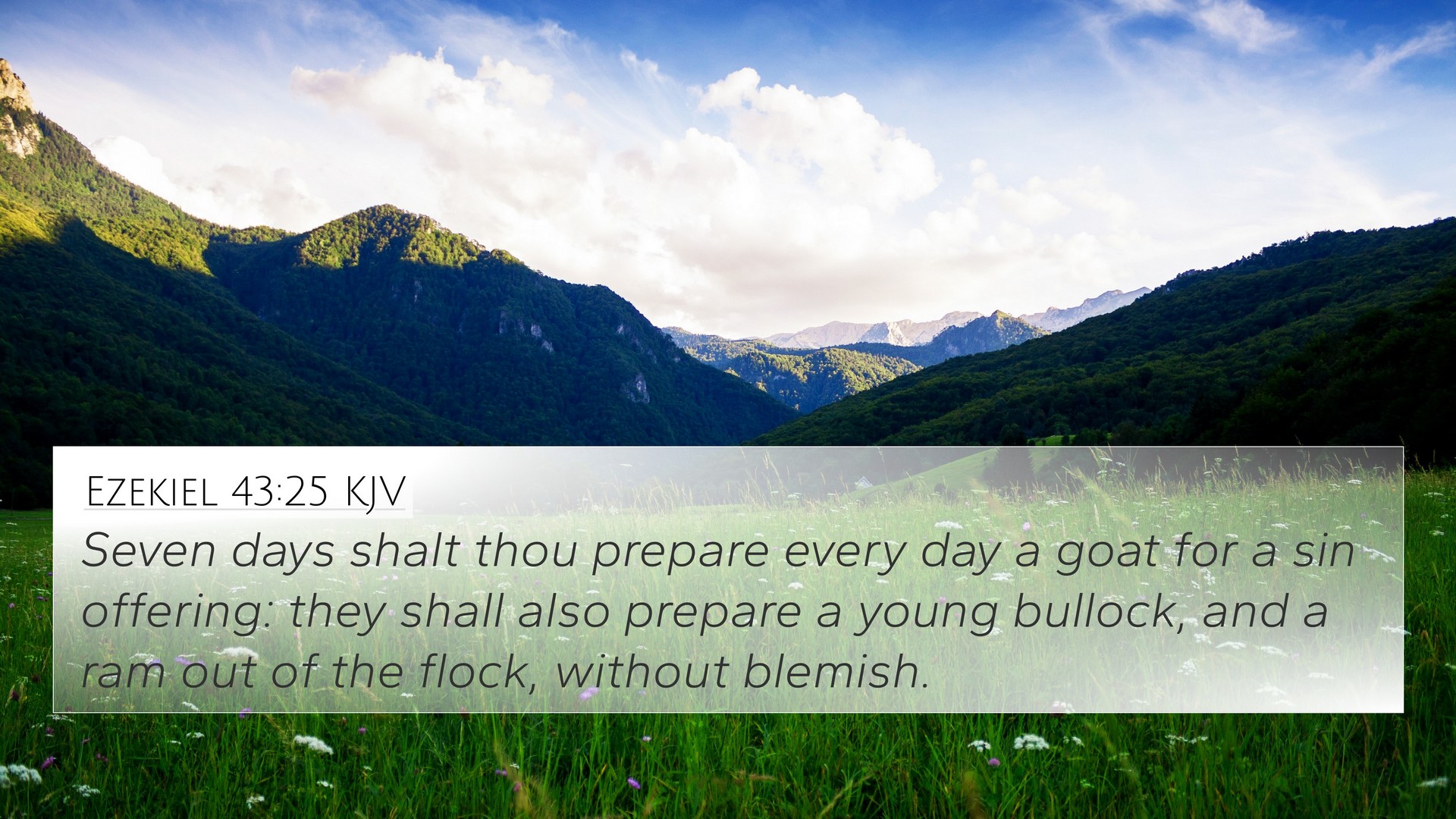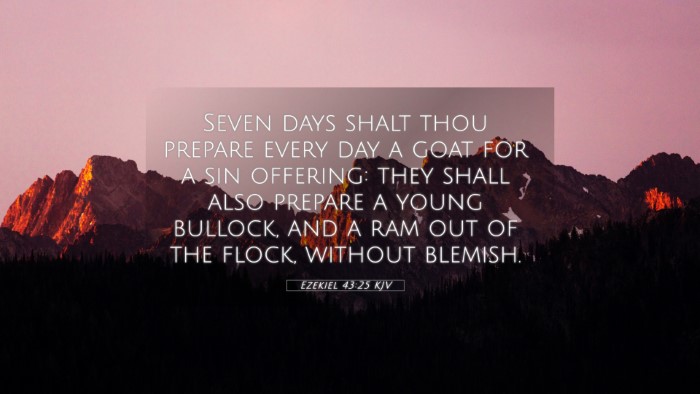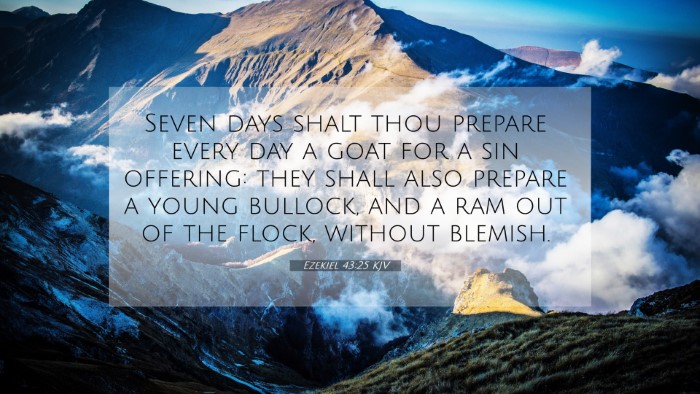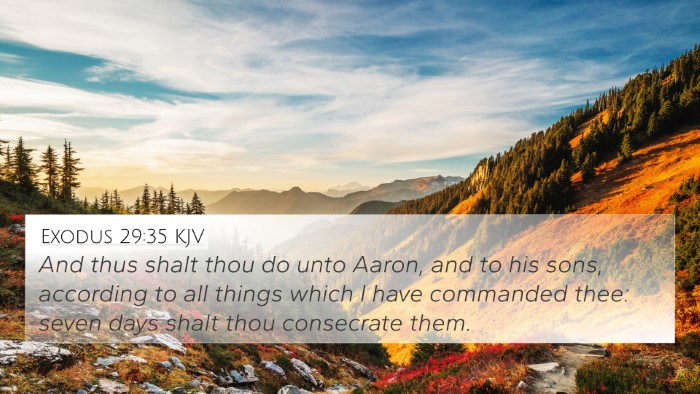Ezekiel 43:25 - Understanding the Verse
Ezekiel 43:25 states: "Seven days shalt thou prepare every day a goat for a sin offering: they shall also prepare a young bullock and a ram out of the flock, without blemish." This verse is part of a prophetic vision given to the prophet Ezekiel concerning the future temple and worship practices of Israel after their restoration.
Summary of Meanings
This passage emphasizes the significance of sacrifice in the worship to God, indicating God's desire for holiness and purity in practices meant to atone for sin. The repeated theme of seven days signifies completion and readiness to facilitate reconciliation with God. A careful study of this verse within the broader context of Ezekiel's visions reveals foundational themes concerning divine worship, priesthood, and atonement.
Commentary Insights
-
Matthew Henry:
Matthew Henry notes that these instructions underline the importance of regular and prescribed sacrifices as part of obedience to God. He emphasizes the unblemished nature of the sacrifices, which represents the necessity for purity in offerings to God. Furthermore, Henry highlights the preparation period reflecting spiritual readiness in coming before God.
-
Albert Barnes:
Albert Barnes elaborates on the significance of the number seven in biblical texts, often symbolizing completeness. He explains that the focus on sin offerings illustrates the seriousness of sin and the continued need for atonement. Barnes connects these practices to the larger theme of restoration and renewal in the Israelite community.
-
Adam Clarke:
Adam Clarke discusses the prophetic implications of this verse, suggesting that the detailed instructions serve to indicate the future precision of worship practices in the restored temple. He identifies the types of sacrifices mentioned as relevant to new covenant practices, further interpreting the significance of the offerings within the context of both Jewish and Christian understandings of atonement.
Cross-References for Ezekiel 43:25
Understanding Ezekiel 43:25 is enriched by comparing it with other scriptures that develop similar themes. Below are some cross-references that elucidate its meaning:
- Leviticus 4:23-24: Discusses sin offerings and the role of the priest in atonement.
- Hebrews 9:22: States that without shedding of blood, there is no remission of sin.
- Isaiah 53:5: Foretells the suffering servant who bears our iniquities and provides atonement.
- Romans 12:1: Paul encourages offering our bodies as living sacrifices, which echoes the theme of sacrificial worship.
- 1 Peter 1:19: Refers to Christ as a lamb without blemish, underscoring the significance of purity in sacrifice.
- Ezekiel 40:39: Provides additional context on the temple's sacrificial system.
- Revelation 5:6: Presents Christ as the Lamb who was slain, tying the sacrificial system to the ultimate sacrifice.
Thematic Connections
Ezekiel 43:25 serves as a crucial component of the larger theological narrative in the Bible. The themes of sacrifice, holiness, and divine restoration create a frameworks that resonates throughout both the Old and New Testaments.
-
Sin and Atonement:
Both the Old Testament sacrificial system and its fulfillment in Christ emphasize God's holiness and the necessity for reconciliation through sacrifice.
-
Preparation for Worship:
The emphasis on preparation reflects the ongoing dialogue in scripture regarding the importance of approaching God with reverence and order.
-
Restoration of Israel:
Ezekiel's prophecies continually return to the theme of Israel's restoration, making this verse integral to understanding God's redemptive plan.
Tools for Bible Cross-Referencing
Understanding the connections between Bible verses can be enhanced through various methods and tools:
- Bible Concordance: A useful resource for finding terms and identifying verse locations across scripture.
- Bible Cross-Reference Guide: Helps locate verses linked by similar themes and concepts.
- Cross-Reference Bible Study: Engages readers in thematic studies using cross-references.
- Bible Reference Resources: Various study Bibles and commentaries provide helpful insights into cross-referenced texts.
Conclusion
Ezekiel 43:25 reminds us of the ongoing biblical themes of atonement, sacrifice, and the call to holiness. It invites us to delve deeper into the connections between various verses and to recognize how they collectively build the narrative of redemption and restoration throughout scripture. The study of these connections through a comparative analysis enriches our understanding and guides our spiritual journey.





